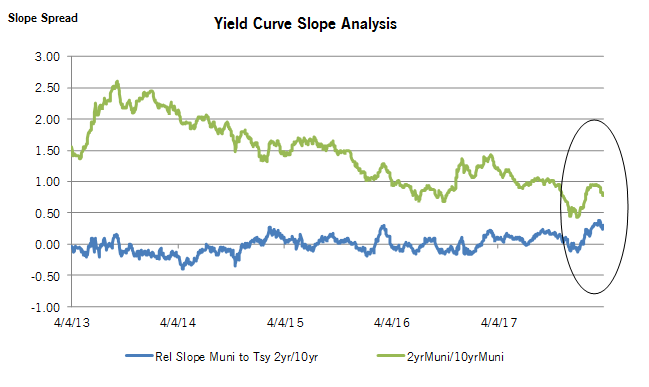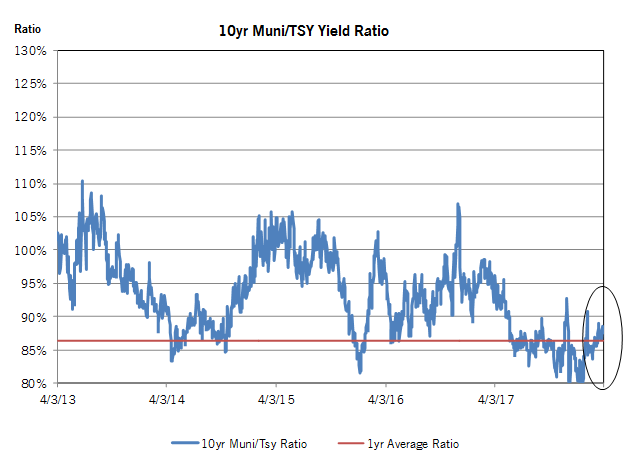Tepid Demand Leads to Steeper Yield Curve
Entering 2018, there was a general consensus that the tax-exempt sector was heading into a more constructive tone, based in large part on very favorable technicals. After an extremely volatile fourth quarter in 2017 that produced a total of $144 Billion in new issuance, with a record $62 Billion in December, the new year was expected to produce a substantial drop in supply. Most of this expected contraction was a direct result of the tax reform that was passed late last year that disallowed tax-exempt advance refundings. New issuance for 2018 was expected to drop by ~23% relative to 2017, with the first quarter expected to produce $62 Billion, a drop of 57% relative to the fourth quarter of 2017.
Demand was also expected to be very supportive. The December through February timeframe is the second strongest period of the year for reinvestment flows of coupons/calls/maturities. The strong demand flows, combined with the expected drop in new issue supply, was expected to produce net supply of negative $41 Billion, a record low for the first quarter.
In looking at the actual performance for the quarter, the results were mixed. Relative performance during January was very strong, as supply/demand imbalances produced a very strong “January effect.” Issuance during the month came in at $20.5B, down 43% relative to January of 2017, and net supply came in at negative $17 Billion. That led to municipal yields to fall by 1 basis points (bps) in 3years and to rise by only 15bps in the 10year maturity between the beginning of the year and January 22nd. This was in stark contrast to the Treasury market which saw rates rise by 23 and 25bps in these years, respectively.
However, relative performance over the balance of the quarter was a different story. Although retail investors remained engaged, the concerns over a further rise in Treasury rates were enough to discourage these investors from moving out of the short-end of the yield curve. Additionally, with tax reform reducing corporate tax rates from 35% to 21%, banks and insurance companies were recalibrating their holdings under the new tax regimen and were finding better after-tax opportunities in the taxable bond sectors. Consequently, there was a heavier flow of overall bid list activity for the quarter relative to historical trends. More notable, from January 23rd to the end of the quarter, average daily bid list activity reported by Bloomberg was approximately 47% higher than the average during the first 22 days of 2018 and 42% higher than the daily average during all of 2017. In addition to their selling flows, the corporate investment segment has only provided very tepid interest on new deal flow activity, resulting in higher market clearing levels in the longer end of the yield curve.
Historically property and casualty companies and banks have provided most of the sponsorship in the 10- to 30-year maturity range.
The net result of the weaker demand from corporate investors and the solid, front-end demand from the retail/household segment has been for the curve to steepen dramatically relative to the Treasury market. Since the beginning of the year, the curve from to 2 to 10years has steepened by 35 bps on an absolute basis and by 40 bps relative to the Treasury curve. The bifurcation in the demand segments has also resulted in municipal-to-Treasury yield ratios in 10yrs for the quarter to rise to 88% from 82%.
In looking forward at our outlook for the second quarter, we are retaining our constructive view for the sector for the balance of the year. However, we could see the steepness of the muni yield curve and relative valuation levels remain at elevated levels for most of the next quarter, before very favorable technicals develop going into the third quarter. The supply/demand imbalances for the June to August time period is expected to produce net supply of negative $61 Billion. That compares favorably with the same time period over the past three years: net supply levels of negative $45.5B last year, negative $13.3B in 2016 and negative $38B in 2015.
In terms of where we find the most value heading into the favorable summer technicals, the 10 year and longer area of the curve looks attractive. The excessive curve steepening that has occurred since the beginning of the year has created an entry point to either put new money to work in the sector or to retain positions in this maturity segment. If we see any meaningful improvement in relative valuation levels and/or substantial relative curve flattening to develop, we would continue to explore a further sector rotation out of tax-exempts and into sectors that provide a better after-tax yield profile.
Disclaimer: Asset Allocation & Management Company, LLC (AAM) is an investment adviser registered with the Securities and Exchange Commission, specializing in fixed-income asset management services for insurance companies. Registration does not imply a certain level of skill or training. This information was developed using publicly available information, internally developed data and outside sources believed to be reliable. While all reasonable care has been taken to ensure that the facts stated and the opinions given are accurate, complete and reasonable, liability is expressly disclaimed by AAM and any affiliates (collectively known as “AAM”), and their representative officers and employees. This report has been prepared for informational purposes only and does not purport to represent a complete analysis of any security, company or industry discussed. Any opinions and/or recommendations expressed are subject to change without notice and should be considered only as part of a diversified portfolio. A complete list of investment recommendations made during the past year is available upon request. Past performance is not an indication of future returns. This information is distributed to recipients including AAM, any of which may have acted on the basis of the information, or may have an ownership interest in securities to which the information relates. It may also be distributed to clients of AAM, as well as to other recipients with whom no such client relationship exists. Providing this information does not, in and of itself, constitute a recommendation by AAM, nor does it imply that the purchase or sale of any security is suitable for the recipient. Investing in the bond market is subject to certain risks including market, interest-rate, issuer, credit, inflation, liquidity, valuation, volatility, prepayment and extension. No part of this material may be reproduced in any form, or referred to in any other publication, without express written permission.
Disclaimer: Asset Allocation & Management Company, LLC (AAM) is an investment adviser registered with the Securities and Exchange Commission, specializing in fixed-income asset management services for insurance companies. Registration does not imply a certain level of skill or training. This information was developed using publicly available information, internally developed data and outside sources believed to be reliable. While all reasonable care has been taken to ensure that the facts stated and the opinions given are accurate, complete and reasonable, liability is expressly disclaimed by AAM and any affiliates (collectively known as “AAM”), and their representative officers and employees. This report has been prepared for informational purposes only and does not purport to represent a complete analysis of any security, company or industry discussed. Any opinions and/or recommendations expressed are subject to change without notice and should be considered only as part of a diversified portfolio. Any opinions and statements contained herein of financial market trends based on market conditions constitute our judgment. This material may contain projections or other forward-looking statements regarding future events, targets or expectations, and is only current as of the date indicated. There is no assurance that such events or targets will be achieved, and may be significantly different than that discussed here. The information presented, including any statements concerning financial market trends, is based on current market conditions, which will fluctuate and may be superseded by subsequent market events or for other reasons. Although the assumptions underlying the forward-looking statements that may be contained herein are believed to be reasonable they can be affected by inaccurate assumptions or by known or unknown risks and uncertainties. AAM assumes no duty to provide updates to any analysis contained herein. A complete list of investment recommendations made during the past year is available upon request. Past performance is not an indication of future returns. This information is distributed to recipients including AAM, any of which may have acted on the basis of the information, or may have an ownership interest in securities to which the information relates. It may also be distributed to clients of AAM, as well as to other recipients with whom no such client relationship exists. Providing this information does not, in and of itself, constitute a recommendation by AAM, nor does it imply that the purchase or sale of any security is suitable for the recipient. Investing in the bond market is subject to certain risks including market, interest-rate, issuer, credit, inflation, liquidity, valuation, volatility, prepayment and extension. No part of this material may be reproduced in any form, or referred to in any other publication, without express written permission.

